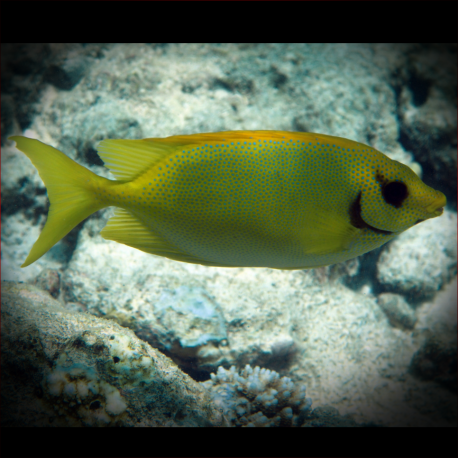More info
Datasheet
| Minimum Tank Size | 1000 litres / 264.17 US gallons |
| Maximum Size | 35.0cm / 13.78inches |
| Reef Compatible | Often reef safe |
| Temperament | Mostly peaceful but might be aggressive towards similar species |
| Temperature | 22.2°C / 71.96°F - 25.6°C / 78.08°F |
| Specific Gravity | 1.020-1.025 |
| Carbonate Hardness | 8-12 |
| pH | 8.1-8.4 |
General Description
The Blue-spotted spinefoot (Siganus corallinus) belongs to the Siganidae family, commonly known as rabbitfish. These fish are recognizable for their blue spots and are efficient algae eaters. They possess toxic spines on their backs, making caution necessary during handling. When threatened, they exhibit color and pattern changes to camouflage.
Aquarium Suitability
Considered suitable for most aquariums, Blue-spotted spinefoot require a very large tank as they can grow up to 35.0cm. They are not recommended for small tanks due to their active swimming behavior and space requirements. These fish thrive in a well-established aquarium with ample algae for grazing and hiding spots like live rocks.
Demands
Blue-spotted spinefoot demand high water quality, with proper oxygenation essential for their well-being. They require a primary diet rich in algae-based food to maintain a healthy immune system. Additionally, they are venomous, with toxins that can cause significant pain but are not usually dangerous to humans.
Care and Hardiness
With an average hardiness level, these rabbitfish can live as a pair and are mostly peaceful but may display aggression towards similar species. They are reef safe when well-fed, typically nibbling on soft coral and LPS if food is insufficient. Providing hiding places, plenty of swimming space, and a varied diet containing macroalgae and microalgae are crucial for their care.
Reef Suitability
Blue-spotted spinefoot are often considered reef safe when adequately fed. They can help control algae growth and are known to graze on algae from rocks and stones in reef aquariums.
Aquarium Setup
Setting up an aquarium for Blue-spotted spinefoot involves creating a well-run environment with sufficient algae on rocks for grazing. Supplementing their diet with algae-rich food like Spirulina is essential if natural algae levels are low. Maintaining a stable water temperature of 22.2-25.6°C, pH levels of 8.1-8.4, and salinity between 1.020-1.025 is crucial.
Behaviour
These fish exhibit peaceful behavior but can turn aggressive towards similar species. They enjoy swimming and require ample space to roam in the aquarium. When threatened, they display protective coloration by changing their patterns to blend with their surroundings.
Feeding and Diet
The Blue-spotted spinefoot primarily feeds on small crustaceans like krill, mysis, and artemia. Their diet should be supplemented with algae-based foods such as Nori seaweed to support their immune system and overall health.
Habitat and Distribution
Blue-spotted spinefoot are native to the Indo-West Pacific, including regions like the Aldabra Islands, Maldives, Indonesia, Australia, and the Philippines. They are commonly found in areas with rocky outcrops where algae-rich environments prevail.
Dimorphism
Male and female Blue-spotted spinefoot can form pairs in the wild or within aquarium settings. They exhibit similar physical characteristics, making visual identification of sex challenging. This species can be challenging to breed in captivity due to specific environmental requirements closely mimicking their natural habitat.

